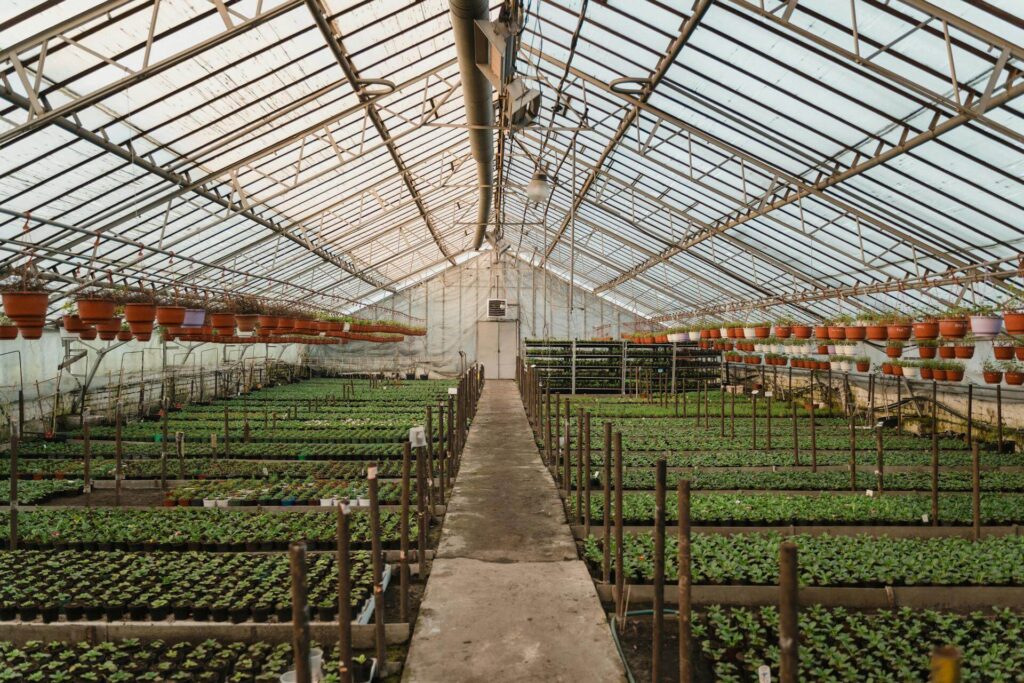All posts
Monitoring Light in Horticulture: Optimising Growth and Sustainability5 December 2024Light is a fundamental resource in horticulture, driving photosynthesis and influencing plant growth, flowering, and yield. Monitoring and managing light exposure effectively can significantly enhance productivity while reducing resource waste. Advanced technologies, including light sensors and dosimeters, are revolutionising horticultural practices by providing precise data on light conditions, helping farmers and growers optimise growth and sustainability.
The Role of Light in Plant Growth
Plants rely on specific wavelengths of light, primarily within the blue and red spectrum, for photosynthesis—the process through which they convert light into energy. Blue light supports vegetative growth, while red light encourages flowering and fruit production. Natural sunlight often provides a mix of these wavelengths, but its intensity and duration can vary due to geographic location, weather, and seasons.
Artificial lighting, such as LED grow lights, allows growers to supplement natural light or simulate ideal lighting conditions indoors. However, balancing light intensity, duration, and spectrum is critical to avoid energy wastage or plant stress.
How Light Monitoring Devices Work
Light sensors and dosimeters measure the intensity, duration, and quality of light in real time. Advanced models can assess specific wavelengths and calculate parameters like Photosynthetically Active Radiation (PAR), which represents the range of light most useful for photosynthesis. These devices enable growers to make data-driven decisions about lighting and shading strategies.
Benefits of Monitoring Light in Horticulture
Optimised Photosynthesis: By providing plants with the ideal light spectrum and intensity, growers can maximise photosynthetic efficiency, leading to healthier plants and higher yields.
Energy Efficiency: Monitoring light conditions helps growers avoid over-lighting, reducing electricity usage and associated costs, particularly in controlled environments like greenhouses and vertical farms.
Seasonal Adaptation: With real-time light data, growers can adjust artificial lighting to compensate for seasonal changes, ensuring consistent plant growth throughout the year.
Pest and Disease Control: Certain light conditions can inhibit the growth of pests and pathogens. For example, UV light has been shown to reduce fungal infections in some crops, and precise light management can help minimise these risks.
Sustainability Goals: Efficient light management reduces the carbon footprint of horticultural operations by cutting energy consumption and supporting eco-friendly practices.
Case Studies and Applications
Greenhouses: Advanced light monitoring systems in greenhouses adjust shading and artificial lighting to maintain optimal conditions for crops, saving energy while ensuring consistent growth.
Vertical Farms: In urban farming setups, where artificial lighting is the primary source, precise light control enhances productivity and reduces operational costs.
Horticultural Research: Researchers use light dosimeters to study the effects of different light spectra on plant growth, leading to innovations in crop-specific lighting strategies.
Challenges and Future Prospects
While light monitoring technology offers immense benefits, its adoption can be hindered by initial setup costs and the need for technical expertise. However, as the technology becomes more affordable and user-friendly, its integration into horticulture is expected to grow.
The future of horticulture lies in sustainable practices that maximise resource use while minimising environmental impact. By leveraging light monitoring systems, growers can achieve higher productivity, improved crop quality, and a more sustainable approach to agriculture.
In conclusion, monitoring light in horticulture is not just a tool for growth—it is a step towards a more efficient, innovative, and sustainable agricultural industry. [...]
Read more...
The Science Behind Light Dosimeters: How They Improve Your Health5 December 2024Light plays a crucial role in human health and well-being. From regulating sleep cycles to boosting mood and energy levels, the right balance of light exposure is essential for optimal functioning. However, modern lifestyles often disconnect us from natural light patterns, leading to potential disruptions in our biological rhythms. This is where a light dosimeter—a device that measures your light exposure—can make a significant impact on your health.
Understanding the Role of Light in Health
Light exposure influences several key biological processes, including:
Circadian RhythmsThe body’s internal clock, or circadian rhythm, is heavily influenced by light. Morning sunlight triggers the production of serotonin, a mood-boosting hormone, and helps regulate the sleep-wake cycle. Conversely, excessive blue light exposure in the evening can suppress melatonin production, leading to poor sleep quality.
Vitamin D ProductionNatural sunlight is a primary source of vitamin D, essential for bone health, immune function, and mood regulation. Insufficient exposure to sunlight can lead to deficiencies, increasing the risk of conditions such as osteoporosis and seasonal affective disorder (SAD).
Mental Health and MoodStudies have shown that light therapy can alleviate symptoms of depression, particularly SAD. Regular exposure to the right intensity and spectrum of light can enhance mood and reduce stress.
What Is a Light Dosimeter?
A light dosimeter is a wearable device that tracks your light exposure throughout the day. It measures the intensity, spectrum, and duration of light you encounter, providing valuable insights into your light environment. These devices are compact, easy to use, and can integrate with health apps to offer personalized recommendations.
How Light Dosimeters Improve Health
Optimizing SleepBy monitoring your exposure to natural and artificial light, a dosimeter can help you adjust your routines to align with your circadian rhythm. For instance, increasing morning light exposure while minimizing blue light at night can significantly improve sleep quality.
Boosting Energy and MoodTracking light levels allows you to identify periods of insufficient exposure. Incorporating short outdoor breaks or adjusting your indoor lighting can enhance mood, energy levels, and productivity throughout the day.
Preventing OverexposureExcessive UV radiation from sunlight can increase the risk of skin damage and cancer. A dosimeter helps you strike a balance by alerting you when UV levels are high, allowing you to take preventive measures like wearing sunscreen or seeking shade.
Personalized Light TherapyFor individuals with conditions such as SAD, a dosimeter can guide effective light therapy by ensuring exposure to the appropriate intensity and duration of light.
Enhancing Indoor EnvironmentsMany people spend a significant portion of their time indoors, often in poorly lit environments. A dosimeter can highlight deficiencies in indoor lighting, encouraging improvements that promote better health and productivity.
Who Can Benefit from a Light Dosimeter?
Office Workers: Monitor indoor light exposure to combat fatigue and maintain energy levels.
Shift Workers: Adjust light exposure to mitigate the effects of irregular schedules on circadian rhythms.
Parents: Ensure children receive adequate daylight to support healthy development.
Seniors: Track light exposure to reduce the risk of sleep disturbances and mood disorders.
Outdoor Enthusiasts: Avoid harmful UV overexposure while enjoying the benefits of natural light.
Conclusion
Wearing a light dosimeter is a simple yet effective way to take control of your light environment and improve your health. By providing real-time insights into your light exposure, these devices empower you to make informed decisions that support better sleep, mood, and overall well-being. As we continue to understand the profound impact of light on health, light dosimeters are poised to become indispensable tools in personal wellness. [...]
Read more...
The Importance of Light Dosimeters in Smart Buildings5 December 2024As we strive for more efficient, sustainable, and comfortable spaces, the role of light dosimeters in smart buildings becomes increasingly significant. These devices, which measure and monitor light levels, are pivotal in enabling smart lighting systems to optimise energy use, enhance occupant comfort, and contribute to sustainability goals.
Enhancing Energy Efficiency
Lighting is one of the major contributors to energy consumption in buildings. Smart lighting systems, integrated with light dosimeters, dynamically adjust artificial lighting based on natural daylight availability. This not only reduces energy wastage but also cuts costs significantly, with savings ranging from 10% to 30% in some cases
Improving Occupant Comfort and Productivity
The human-centric approach of smart lighting systems, supported by light dosimeters, ensures that indoor environments remain well-lit and adaptive to users’ needs. By regulating light intensity and colour temperature, these systems can align with the natural circadian rhythms of occupants, boosting mood, productivity, and even sleep quality
Contributing to Sustainability
Light dosimeters help smart buildings minimise their environmental impact. By enabling efficient energy use and reducing reliance on non-renewable resources, these systems play a critical role in lowering carbon footprints and achieving green certifications like LEED
Beyond Energy: Additional Benefits
Light dosimeters also support other smart building functionalities, such as occupancy detection and space optimisation. These features allow facility managers to gather insights into building usage patterns, improve layouts, and integrate other systems like HVAC to enhance overall efficiency
Challenges and the Way Forward
Despite their benefits, the adoption of light dosimeters in smart buildings faces hurdles such as upfront costs and data privacy concerns. However, the long-term benefits, including operational savings and improved occupant well-being, make a compelling case for widespread implementation.
Smart buildings represent the future of urban living, and technologies like light dosimeters are at the heart of this transformation. As innovations continue, their integration will undoubtedly redefine how we interact with our built environments. [...]
Read more...



